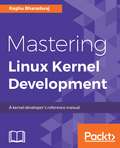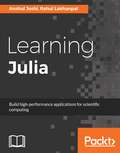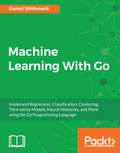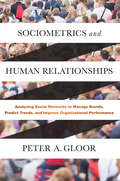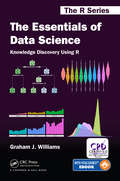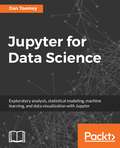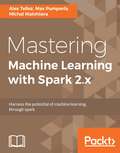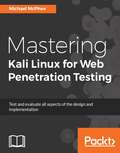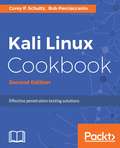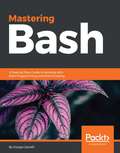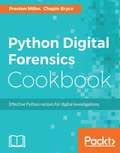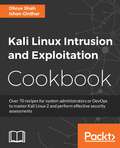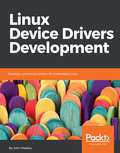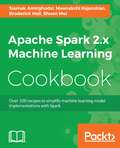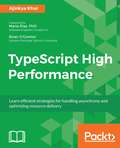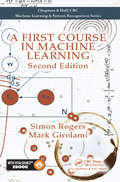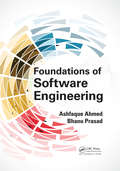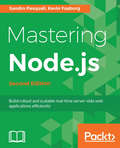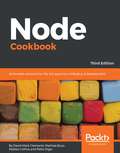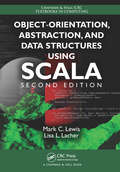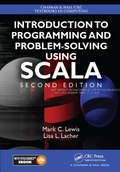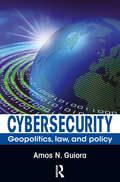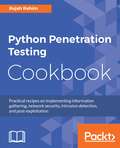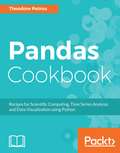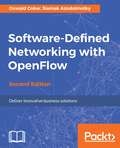- Table View
- List View
Mastering Linux Kernel Development: A kernel developer's reference manual
by Raghu BharadwajExplore Implementation of core kernel subsystems About This Book • Master the design, components, and structures of core kernel subsystems • Explore kernel programming interfaces and related algorithms under the hood • Completely updated material for the 4.12.10 kernel Who This Book Is For If you are a kernel programmer with a knowledge of kernel APIs and are looking to build a comprehensive understanding, and eager to explore the implementation, of kernel subsystems, this book is for you. It sets out to unravel the underlying details of kernel APIs and data structures, piercing through the complex kernel layers and gives you the edge you need to take your skills to the next level. What You Will Learn • Comprehend processes and fles—the core abstraction mechanisms of the Linux kernel that promote effective simplification and dynamism • Decipher process scheduling and understand effective capacity utilization under general and real-time dispositions • Simplify and learn more about process communication techniques through signals and IPC mechanisms • Capture the rudiments of memory by grasping the key concepts and principles of physical and virtual memory management • Take a sharp and precise look at all the key aspects of interrupt management and the clock subsystem • Understand concurrent execution on SMP platforms through kernel synchronization and locking techniques In Detail Mastering Linux Kernel Development looks at the Linux kernel, its internal arrangement and design, and various core subsystems, helping you to gain significant understanding of this open source marvel. You will look at how the Linux kernel, which possesses a kind of collective intelligence thanks to its scores of contributors, remains so elegant owing to its great design. This book also looks at all the key kernel code, core data structures, functions, and macros, giving you a comprehensive foundation of the implementation details of the kernel's core services and mechanisms. You will also look at the Linux kernel as well-designed software, which gives us insights into software design in general that are easily scalable yet fundamentally strong and safe. By the end of this book, you will have considerable understanding of and appreciation for the Linux kernel. Style and approach Each chapter begins with the basic conceptual know-how for a subsystem and extends into the details of its implementation. We use appropriate code excerpts of critical routines and data structures for subsystems.
Learning Julia
by Anshul JoshiThis book allows existing programmers, statisticians, and data scientists to learn and take advantage of Julia while building applications with complex numerical and scientific computations. A basic knowledge of mathematics is required to understand the various methods that will be used or created in the book and exploit Julia's capabilities.
Machine Learning With Go: Implement Regression, Classification, Clustering, Time-series Models, Neural Networks, and More using the Go Programming Language
by Daniel WhitenackBuild simple, maintainable, and easy to deploy machine learning applications. About This Book • Build simple, but powerful, machine learning applications that leverage Go's standard library along with popular Go packages. • Learn the statistics, algorithms, and techniques needed to successfully implement machine learning in Go • Understand when and how to integrate certain types of machine learning model in Go applications. Who This Book Is For This book is for Go developers who are familiar with the Go syntax and can develop, build, and run basic Go programs. If you want to explore the field of machine learning and you love Go, then this book is for you! Machine Learning with Go will give readers the practical skills to perform the most common machine learning tasks with Go. Familiarity with some statistics and math topics is necessary. What You Will Learn • Learn about data gathering, organization, parsing, and cleaning. • Explore matrices, linear algebra, statistics, and probability. • See how to evaluate and validate models. • Look at regression, classification, clustering. • Learn about neural networks and deep learning • Utilize times series models and anomaly detection. • Get to grip with techniques for deploying and distributing analyses and models. • Optimize machine learning workflow techniques In Detail The mission of this book is to turn readers into productive, innovative data analysts who leverage Go to build robust and valuable applications. To this end, the book clearly introduces the technical aspects of building predictive models in Go, but it also helps the reader understand how machine learning workflows are being applied in real-world scenarios. Machine Learning with Go shows readers how to be productive in machine learning while also producing applications that maintain a high level of integrity. It also gives readers patterns to overcome challenges that are often encountered when trying to integrate machine learning in an engineering organization. The readers will begin by gaining a solid understanding of how to gather, organize, and parse real-work data from a variety of sources. Readers will then develop a solid statistical toolkit that will allow them to quickly understand gain intuition about the content of a dataset. Finally, the readers will gain hands-on experience implementing essential machine learning techniques (regression, classification, clustering, and so on) with the relevant Go packages. Finally, the reader will have a solid machine learning mindset and a powerful Go toolkit of techniques, packages, and example implementations. Style and approach This book connects the fundamental, theoretical concepts behind Machine Learning to practical implementations using the Go programming language.
Sociometrics and Human Relationships: Analyzing Social Networks to Manage Brands, Predict Trends, and Improve Organizational Performance
by Peter A. GloorSociometrics and Human Relationships translates the latest academic research into practical business strategies and techniques as well as actionable insights, providing a wealth of examples for social network analysis and predicting trends. Gloor illustrates how to improve organizational performance by optimizing communication and collaboration through email. Based on Collaborative Innovation Networks courses which have been taught for over a decade to students forming virtual teams across a number of universities, Gloor shows readers how to leverage virtual collaborative creativity in the Internet age, and helps them understand and apply the dynamics of online communication via a variety of tools. Gloor has also created a tool that analyses all types of social media such as: Twitter, Wikipedia, online blogs and Facebook as well as email or Skype logs to predict election outcomes, perception and strength of brands, customer and employment satisfaction, or fraudulent behavior. Gloor explains how to use his tool, Condor, to visualize, monitor and manage brands, products and topics online, as well as analyzing organizations through their email networks.
The Essentials of Data Science: Knowledge Discovery Using R (Chapman & Hall/CRC The R Series)
by Graham J. WilliamsThe Essentials of Data Science: Knowledge Discovery Using R presents the concepts of data science through a hands-on approach using free and open source software. It systematically drives an accessible journey through data analysis and machine learning to discover and share knowledge from data.Building on over thirty years’ experience in teaching and practising data science, the author encourages a programming-by-example approach to ensure students and practitioners attune to the practise of data science while building their data skills. Proven frameworks are provided as reusable templates. Real world case studies then provide insight for the data scientist to swiftly adapt the templates to new tasks and datasets. The book begins by introducing data science. It then reviews R’s capabilities for analysing data by writing computer programs. These programs are developed and explained step by step. From analysing and visualising data, the framework moves on to tried and tested machine learning techniques for predictive modelling and knowledge discovery. Literate programming and a consistent style are a focus throughout the book.
Jupyter for Data Science
by Dan ToomeyYour one-stop guide to building an efficient data science pipeline using Jupyter About This Book • Get the most out of your Jupyter notebook to complete the trickiest of tasks in Data Science • Learn all the tasks in the data science pipeline—from data acquisition to visualization—and implement them using Jupyter • Get ahead of the curve by mastering all the applications of Jupyter for data science with this unique and intuitive guide Who This Book Is For This book targets students and professionals who wish to master the use of Jupyter to perform a variety of data science tasks. Some programming experience with R or Python, and some basic understanding of Jupyter, is all you need to get started with this book. What You Will Learn • Understand why Jupyter notebooks are a perfect fit for your data science tasks • Perform scientific computing and data analysis tasks with Jupyter • Interpret and explore different kinds of data visually with charts, histograms, and more • Extend SQL's capabilities with Jupyter notebooks • Combine the power of R and Python 3 with Jupyter to create dynamic notebooks • Create interactive dashboards and dynamic presentations • Master the best coding practices and deploy your Jupyter notebooks efficiently In Detail Jupyter Notebook is a web-based environment that enables interactive computing in notebook documents. It allows you to create documents that contain live code, equations, and visualizations. This book is a comprehensive guide to getting started with data science using the popular Jupyter notebook. If you are familiar with Jupyter notebook and want to learn how to use its capabilities to perform various data science tasks, this is the book for you! From data exploration to visualization, this book will take you through every step of the way in implementing an effective data science pipeline using Jupyter. You will also see how you can utilize Jupyter's features to share your documents and codes with your colleagues. The book also explains how Python 3, R, and Julia can be integrated with Jupyter for various data science tasks. By the end of this book, you will comfortably leverage the power of Jupyter to perform various tasks in data science successfully. Style and approach This book is a perfect blend of concepts and practical examples, written in a way that is very easy to understand and implement. It follows a logical flow where you will be able to build on your understanding of the different Jupyter features with every chapter.
Mastering Machine Learning with Spark 2.x
by Alex Tellez Max Pumperla Michal MalohlavaUnlock the complexities of machine learning algorithms in Spark to generate useful data insights through this data analysis tutorial About This Book • Process and analyze big data in a distributed and scalable way • Write sophisticated Spark pipelines that incorporate elaborate extraction • Build and use regression models to predict flight delays Who This Book Is For Are you a developer with a background in machine learning and statistics who is feeling limited by the current slow and “small data” machine learning tools? Then this is the book for you! In this book, you will create scalable machine learning applications to power a modern data-driven business using Spark. We assume that you already know the machine learning concepts and algorithms and have Spark up and running (whether on a cluster or locally) and have a basic knowledge of the various libraries contained in Spark. What You Will Learn • Use Spark streams to cluster tweets online • Run the PageRank algorithm to compute user influence • Perform complex manipulation of DataFrames using Spark • Define Spark pipelines to compose individual data transformations • Utilize generated models for off-line/on-line prediction • Transfer the learning from an ensemble to a simpler Neural Network • Understand basic graph properties and important graph operations • Use GraphFrames, an extension of DataFrames to graphs, to study graphs using an elegant query language • Use K-means algorithm to cluster movie reviews dataset In Detail The purpose of machine learning is to build systems that learn from data. Being able to understand trends and patterns in complex data is critical to success; it is one of the key strategies to unlock growth in the challenging contemporary marketplace today. With the meteoric rise of machine learning, developers are now keen on finding out how can they make their Spark applications smarter. This book gives you access to transform data into actionable knowledge. The book commences by defining machine learning primitives by the MLlib and H2O libraries. You will learn how to use Binary classification to detect the Higgs Boson particle in the huge amount of data produced by CERN particle collider and classify daily health activities using ensemble Methods for Multi-Class Classification. Next, you will solve a typical regression problem involving flight delay predictions and write sophisticated Spark pipelines. You will analyze Twitter data with help of the doc2vec algorithm and K-means clustering. Finally, you will build different pattern mining models using MLlib, perform complex manipulation of DataFrames using Spark and Spark SQL, and deploy your app in a Spark streaming environment. Style and approach This book takes a practical approach to help you get to grips with using Spark for analytics and to implement machine learning algorithms. We'll teach you about advanced applications of machine learning through illustrative examples. These examples will equip you to harness the potential of machine learning, through Spark, in a variety of enterprise-grade systems.
Mastering Kali Linux for Web Penetration Testing
by Michael McPheeMaster the art of exploiting advanced web penetration techniques with Kali Linux 2016.2 About This Book • Make the most out of advanced web pen-testing techniques using Kali Linux 2016.2 • Explore how Stored (a.k.a. Persistent) XSS attacks work and how to take advantage of them • Learn to secure your application by performing advanced web based attacks. • Bypass internet security to traverse from the web to a private network. Who This Book Is For This book targets IT pen testers, security consultants, and ethical hackers who want to expand their knowledge and gain expertise on advanced web penetration techniques. Prior knowledge of penetration testing would be beneficial. What You Will Learn • Establish a fully-featured sandbox for test rehearsal and risk-free investigation of applications • Enlist open-source information to get a head-start on enumerating account credentials, mapping potential dependencies, and discovering unintended backdoors and exposed information • Map, scan, and spider web applications using nmap/zenmap, nikto, arachni, webscarab, w3af, and NetCat for more accurate characterization • Proxy web transactions through tools such as Burp Suite, OWASP's ZAP tool, and Vega to uncover application weaknesses and manipulate responses • Deploy SQL injection, cross-site scripting, Java vulnerabilities, and overflow attacks using Burp Suite, websploit, and SQLMap to test application robustness • Evaluate and test identity, authentication, and authorization schemes and sniff out weak cryptography before the black hats do In Detail You will start by delving into some common web application architectures in use, both in private and public cloud instances. You will also learn about the most common frameworks for testing, such as OWASP OGT version 4, and how to use them to guide your efforts. In the next section, you will be introduced to web pentesting with core tools and you will also see how to make web applications more secure through rigorous penetration tests using advanced features in open source tools. The book will then show you how to better hone your web pentesting skills in safe environments that can ensure low-risk experimentation with the powerful tools and features in Kali Linux that go beyond a typical script-kiddie approach. After establishing how to test these powerful tools safely, you will understand how to better identify vulnerabilities, position and deploy exploits, compromise authentication and authorization, and test the resilience and exposure applications possess. By the end of this book, you will be well-versed with the web service architecture to identify and evade various protection mechanisms that are used on the Web today. You will leave this book with a greater mastery of essential test techniques needed to verify the secure design, development, and operation of your customers' web applications. Style and approach An advanced-level guide filled with real-world examples that will help you take your web application's security to the next level by using Kali Linux 2016.2.
Kali Linux Cookbook - Second Edition
by Corey P. Schultz Bob PerciaccanteOver 80 recipes to effectively test your network and boost your career in security About This Book • Learn how to scan networks to find vulnerable computers and servers • Hack into devices to control them, steal their data, and make them yours • Target wireless networks, databases, and web servers, and password cracking to make the most of Kali Linux Who This Book Is For If you are looking to expand your career into penetration testing, you will need a good understanding of Kali Linux and the variety of tools it includes. This book will work as a perfect guide for anyone who wants to have a practical approach in leveraging penetration testing mechanisms using Kali Linux What You Will Learn • Acquire the key skills of ethical hacking to perform penetration testing • Learn how to perform network reconnaissance • Discover vulnerabilities in hosts • Attack vulnerabilities to take control of workstations and servers • Understand password cracking to bypass security • Learn how to hack into wireless networks • Attack web and database servers to exfiltrate data • Obfuscate your command and control connections to avoid firewall and IPS detection In Detail Kali Linux is a Linux distribution designed for penetration testing and security auditing. It is the successor to BackTrack, the world's most popular penetration testing distribution. Kali Linux is the most widely used platform and toolkit for penetration testing. Security is currently the hottest field in technology with a projected need for millions of security professionals. This book focuses on enhancing your knowledge in Kali Linux for security by expanding your skills with toolkits and frameworks that can increase your value as a security professional. Kali Linux Cookbook, Second Edition starts by helping you install Kali Linux on different options available. You will also be able to understand the lab architecture and install a Windows host for use in the lab. Next, you will understand the concept of vulnerability analysis and look at the different types of exploits. The book will introduce you to the concept and psychology of Social Engineering and password cracking. You will then be able to use these skills to expand the scope of any breaches you create. Finally, the book will guide you in exploiting specific technologies and gaining access to other systems in the environment. By the end of this book, you will have gained the core knowledge and concepts of the penetration testing process. Style and approach This book teaches you everything you need to know about Kali Linux from the perspective of a penetration tester. It is filled with powerful recipes and practical examples that will help you gain in-depth knowledge of Kali Linux.
Mastering Bash
by Giorgio ZarrelliYour one stop guide to making the most out of Bash programming About This Book • From roots to leaves, learn how to program in Bash and automate daily tasks, pouring some spice in your scripts • Daemonize a script and make a real service of it, ensuring it's available at any time to process user-fed data or commands • This book provides functional examples that show you practical applications of commands Who This Book Is For If you're a power user or system administrator involved in writing Bash scripts to automate tasks, then this book is for you. This book is also ideal for advanced users who are engaged in complex daily tasks. What You Will Learn • Understand Bash right from the basics and progress to an advanced level • Customise your environment and automate system routine tasks • Write structured scripts and create a command-line interface for your scripts • Understand arrays, menus, and functions • Securely execute remote commands using ssh • Write Nagios plugins to automate your infrastructure checks • Interact with web services, and a Slack notification script • Find out how to execute subshells and take advantage of parallelism • Explore inter-process communication and write your own daemon In Detail System administration is an everyday effort that involves a lot of tedious tasks, and devious pits. Knowing your environment is the key to unleashing the most powerful solution that will make your life easy as an administrator, and show you the path to new heights. Bash is your Swiss army knife to set up your working or home environment as you want, when you want. This book will enable you to customize your system step by step, making your own real, virtual, home out of it. The journey will take you swiftly through the basis of the shell programming in Bash to more interesting and challenging tasks. You will be introduced to one of the most famous open source monitoring systems—Nagios, and write complex programs with it in any languages. You'll see how to perform checks on your sites and applications. Moving on, you'll discover how to write your own daemons so you can create your services and take advantage of inter-process communication to let your scripts talk to each other. So, despite these being everyday tasks, you'll have a lot of fun on the way. By the end of the book, you will have gained advanced knowledge of Bash that will help you automate routine tasks and manage your systems. Style and approach This book presents step-by-step instructions and expert advice on working with Bash and writing scripts. Starting from the basics, this book serves as a reference manual where you can find handy solutions and advice to make your scripts flexible and powerful.
Python Digital Forensics Cookbook: Effective Python recipes for digital investigations
by Preston Miller Chapin BryceOver 60 recipes to help you learn digital forensics and leverage Python scripts to amplify your examinations About This Book • Develop code that extracts vital information from everyday forensic acquisitions. • Increase the quality and efficiency of your forensic analysis. • Leverage the latest resources and capabilities available to the forensic community. Who This Book Is For If you are a digital forensics examiner, cyber security specialist, or analyst at heart, understand the basics of Python, and want to take it to the next level, this is the book for you. Along the way, you will be introduced to a number of libraries suitable for parsing forensic artifacts. Readers will be able to use and build upon the scripts we develop to elevate their analysis. What You Will Learn • Understand how Python can enhance digital forensics and investigations • Learn to access the contents of, and process, forensic evidence containers • Explore malware through automated static analysis • Extract and review message contents from a variety of email formats • Add depth and context to discovered IP addresses and domains through various Application Program Interfaces (APIs) • Delve into mobile forensics and recover deleted messages from SQLite databases • Index large logs into a platform to better query and visualize datasets In Detail Technology plays an increasingly large role in our daily lives and shows no sign of stopping. Now, more than ever, it is paramount that an investigator develops programming expertise to deal with increasingly large datasets. By leveraging the Python recipes explored throughout this book, we make the complex simple, quickly extracting relevant information from large datasets. You will explore, develop, and deploy Python code and libraries to provide meaningful results that can be immediately applied to your investigations. Throughout the Python Digital Forensics Cookbook, recipes include topics such as working with forensic evidence containers, parsing mobile and desktop operating system artifacts, extracting embedded metadata from documents and executables, and identifying indicators of compromise. You will also learn to integrate scripts with Application Program Interfaces (APIs) such as VirusTotal and PassiveTotal, and tools such as Axiom, Cellebrite, and EnCase. By the end of the book, you will have a sound understanding of Python and how you can use it to process artifacts in your investigations. Style and approach Our succinct recipes take a no-frills approach to solving common challenges faced in investigations. The code in this book covers a wide range of artifacts and data sources. These examples will help improve the accuracy and efficiency of your analysis—no matter the situation.
Kali Linux Intrusion and Exploitation Cookbook
by Dhruv Shah Ishan GirdharOver 70 recipes for system administrators or DevOps to master Kali Linux 2 and perform effective security assessments About This Book • Set up a penetration testing lab to conduct a preliminary assessment of attack surfaces and run exploits • Improve your testing efficiency with the use of automated vulnerability scanners • Work through step-by-step recipes to detect a wide array of vulnerabilities, exploit them to analyze their consequences, and identify security anomalies Who This Book Is For This book is intended for those who want to know more about information security. In particular, it's ideal for system administrators and system architects who want to ensure that the infrastructure and systems they are creating and managing are secure. This book helps both beginners and intermediates by allowing them to use it as a reference book and to gain in-depth knowledge. What You Will Learn • Understand the importance of security assessments over merely setting up and managing systems/processes • Familiarize yourself with tools such as OPENVAS to locate system and network vulnerabilities • Discover multiple solutions to escalate privileges on a compromised machine • Identify security anomalies in order to make your infrastructure secure and further strengthen it • Acquire the skills to prevent infrastructure and application vulnerabilities • Exploit vulnerabilities that require a complex setup with the help of Metasploit In Detail With the increasing threats of breaches and attacks on critical infrastructure, system administrators and architects can use Kali Linux 2.0 to ensure their infrastructure is secure by finding out known vulnerabilities and safeguarding their infrastructure against unknown vulnerabilities. This practical cookbook-style guide contains chapters carefully structured in three phases – information gathering, vulnerability assessment, and penetration testing for the web, and wired and wireless networks. It's an ideal reference guide if you're looking for a solution to a specific problem or learning how to use a tool. We provide hands-on examples of powerful tools/scripts designed for exploitation. In the final section, we cover various tools you can use during testing, and we help you create in-depth reports to impress management. We provide system engineers with steps to reproduce issues and fix them. Style and approach This practical book is full of easy-to-follow recipes with based on real-world problems faced by the authors. Each recipe is divided into three sections, clearly defining what the recipe does, what you need, and how to do it. The carefully structured recipes allow you to go directly to your topic of interest.
Linux Device Drivers Development
by John MadieuLearn to develop customized device drivers for your embedded Linux system About This Book • Learn to develop customized Linux device drivers • Learn the core concepts of device drivers such as memory management, kernel caching, advanced IRQ management, and so on. • Practical experience on the embedded side of Linux Who This Book Is For This book will help anyone who wants to get started with developing their own Linux device drivers for embedded systems. Embedded Linux users will benefit highly from this book. This book covers all about device driver development, from char drivers to network device drivers to memory management. What You Will Learn • Use kernel facilities to develop powerful drivers • Develop drivers for widely used I2C and SPI devices and use the regmap API • Write and support devicetree from within your drivers • Program advanced drivers for network and frame buffer devices • Delve into the Linux irqdomain API and write interrupt controller drivers • Enhance your skills with regulator and PWM frameworks • Develop measurement system drivers with IIO framework • Get the best from memory management and the DMA subsystem • Access and manage GPIO subsystems and develop GPIO controller drivers In Detail Linux kernel is a complex, portable, modular and widely used piece of software, running on around 80% of servers and embedded systems in more than half of devices throughout the World. Device drivers play a critical role in how well a Linux system performs. As Linux has turned out to be one of the most popular operating systems used, the interest in developing proprietary device drivers is also increasing steadily. This book will initially help you understand the basics of drivers as well as prepare for the long journey through the Linux Kernel. This book then covers drivers development based on various Linux subsystems such as memory management, PWM, RTC, IIO, IRQ management, and so on. The book also offers a practical approach on direct memory access and network device drivers. By the end of this book, you will be comfortable with the concept of device driver development and will be in a position to write any device driver from scratch using the latest kernel version (v4.13 at the time of writing this book). Style and approach A set of engaging examples to develop Linux device drivers
Apache Spark 2.x Machine Learning Cookbook
by Siamak Amirghodsi Meenakshi Rajendran Broderick Hall Shuen MeiSimplify machine learning model implementations with Spark About This Book • Solve the day-to-day problems of data science with Spark • This unique cookbook consists of exciting and intuitive numerical recipes • Optimize your work by acquiring, cleaning, analyzing, predicting, and visualizing your data Who This Book Is For This book is for Scala developers with a fairly good exposure to and understanding of machine learning techniques, but lack practical implementations with Spark. A solid knowledge of machine learning algorithms is assumed, as well as hands-on experience of implementing ML algorithms with Scala. However, you do not need to be acquainted with the Spark ML libraries and ecosystem. What You Will Learn • Get to know how Scala and Spark go hand-in-hand for developers when developing ML systems with Spark • Build a recommendation engine that scales with Spark • Find out how to build unsupervised clustering systems to classify data in Spark • Build machine learning systems with the Decision Tree and Ensemble models in Spark • Deal with the curse of high-dimensionality in big data using Spark • Implement Text analytics for Search Engines in Spark • Streaming Machine Learning System implementation using Spark In Detail Machine learning aims to extract knowledge from data, relying on fundamental concepts in computer science, statistics, probability, and optimization. Learning about algorithms enables a wide range of applications, from everyday tasks such as product recommendations and spam filtering to cutting edge applications such as self-driving cars and personalized medicine. You will gain hands-on experience of applying these principles using Apache Spark, a resilient cluster computing system well suited for large-scale machine learning tasks. This book begins with a quick overview of setting up the necessary IDEs to facilitate the execution of code examples that will be covered in various chapters. It also highlights some key issues developers face while working with machine learning algorithms on the Spark platform. We progress by uncovering the various Spark APIs and the implementation of ML algorithms with developing classification systems, recommendation engines, text analytics, clustering, and learning systems. Toward the final chapters, we'll focus on building high-end applications and explain various unsupervised methodologies and challenges to tackle when implementing with big data ML systems. Style and approach This book is packed with intuitive recipes supported with line-by-line explanations to help you understand how to optimize your work flow and resolve problems when working with complex data modeling tasks and predictive algorithms. This is a valuable resource for data scientists and those working on large scale data projects.
TypeScript High Performance
by Ajinkya KherGet lightning speed performance by writing highly efficient code in TypeScript About This Book • Efficiently use Data Structures, Language Constructs, & Handle Asynchrony • Monitor the performance, Code Quality, & Resource Optimizations • Build & Deploy Strategies for Large Scale TypeScript Projects Who This Book Is For This book is for people who have basic knowledge of TypeScript. Experience using JavaScript and familiarity with front end development are the prerequisites. What You Will Learn • Learn about the critical rendering path, and the performance metrics involved along the same • Explore the detailed inner intricacies of a web browser • Build a large scale front end applications and learn the thought process behind architecting such an effort • Understand the challenges of scalability and how TypeScript renders itself to the cause • Learn efficient usage of TypeScript constructs to deliver high performance and avoid common mistakes and pitfalls that can hamper performance • Monitor performance, resolve and detect performance bottlenecks in production, and learn the tools involved In Detail In a world where a tiny decrease in frames per second impacts customer engagement greatly, writing highly scalable code is more of a necessity than a luxury. Using TypeScript you get type checking during development. This gives you the power to write optimized code quickly. This book is also a solid tool to those who're curious to understand the impact of performance in production, and it is of the greatest aid to the proactive developers who like to be cognizant of and avoid the classic pitfalls while coding. The book will starts with explaining the efficient implementation of basic data Structures, data types, and flow control. You will then learn efficient use of advanced language constructs and asynchronous programming. Further, you'll learn different configurations available with TSLint to improve code quality and performance. Next, we'll introduce you to the concepts of profiling and then we deep dive into profiling JS with several tools such as firebug, chrome, fiddler. Finally, you'll learn techniques to build and deploy real world large scale TypeScript applications. Style and approach This book will be a step by step easy to follow guide with focused examples to increase performance of applications and provide optimization techniques.
A First Course in Machine Learning
by Simon Rogers Mark Girolami"A First Course in Machine Learning by Simon Rogers and Mark Girolami is the best introductory book for ML currently available. It combines rigor and precision with accessibility, starts from a detailed explanation of the basic foundations of Bayesian analysis in the simplest of settings, and goes all the way to the frontiers of the subject such as infinite mixture models, GPs, and MCMC."—Devdatt Dubhashi, Professor, Department of Computer Science and Engineering, Chalmers University, Sweden "This textbook manages to be easier to read than other comparable books in the subject while retaining all the rigorous treatment needed. The new chapters put it at the forefront of the field by covering topics that have become mainstream in machine learning over the last decade."—Daniel Barbara, George Mason University, Fairfax, Virginia, USA "The new edition of A First Course in Machine Learning by Rogers and Girolami is an excellent introduction to the use of statistical methods in machine learning. The book introduces concepts such as mathematical modeling, inference, and prediction, providing ‘just in time’ the essential background on linear algebra, calculus, and probability theory that the reader needs to understand these concepts."—Daniel Ortiz-Arroyo, Associate Professor, Aalborg University Esbjerg, Denmark "I was impressed by how closely the material aligns with the needs of an introductory course on machine learning, which is its greatest strength…Overall, this is a pragmatic and helpful book, which is well-aligned to the needs of an introductory course and one that I will be looking at for my own students in coming months."—David Clifton, University of Oxford, UK "The first edition of this book was already an excellent introductory text on machine learning for an advanced undergraduate or taught masters level course, or indeed for anybody who wants to learn about an interesting and important field of computer science. The additional chapters of advanced material on Gaussian process, MCMC and mixture modeling provide an ideal basis for practical projects, without disturbing the very clear and readable exposition of the basics contained in the first part of the book." —Gavin Cawley, Senior Lecturer, School of Computing Sciences, University of East Anglia, UK "This book could be used for junior/senior undergraduate students or first-year graduate students, as well as individuals who want to explore the field of machine learning…The book introduces not only the concepts but the underlying ideas on algorithm implementation from a critical thinking perspective."—Guangzhi Qu, Oakland University, Rochester, Michigan, USA
Foundations of Software Engineering
by Ashfaque Ahmed Bhanu PrasadThe best way to learn software engineering is by understanding its core and peripheral areas. Foundations of Software Engineering provides in-depth coverage of the areas of software engineering that are essential for becoming proficient in the field. The book devotes a complete chapter to each of the core areas. Several peripheral areas are also explained by assigning a separate chapter to each of them. Rather than using UML or other formal notations, the content in this book is explained in easy-to-understand language. Basic programming knowledge using an object-oriented language is helpful to understand the material in this book. The knowledge gained from this book can be readily used in other relevant courses or in real-world software development environments.This textbook educates students in software engineering principles. It covers almost all facets of software engineering, including requirement engineering, system specifications, system modeling, system architecture, system implementation, and system testing. Emphasizing practical issues, such as feasibility studies, this book explains how to add and develop software requirements to evolve software systems.This book was written after receiving feedback from several professors and software engineers. What resulted is a textbook on software engineering that not only covers the theory of software engineering but also presents real-world insights to aid students in proper implementation. Students learn key concepts through carefully explained and illustrated theories, as well as concrete examples and a complete case study using Java. Source code is also available on the book’s website. The examples and case studies increase in complexity as the book progresses to help students build a practical understanding of the required theories and applications.
Mastering Node.js: Build Robust And Scalable Real-time Server-side Web Applications Efficiently
by Sandro PasqualiNode.js with its strong features and ability to write server as well as client side code with JavaScript has become a popular choice amongst developers for building powerful web applications. This book is a deep dive into showing facets of Node which are helpful for creating highly concurrent and scalable real time applications.
Node Cookbook - Third Edition: Actionable solutions for the full spectrum of Node.js 8 development
by David Mark Clements Matteo Collina Matthias Buus Peter ElgerOver 60 high-quality recipes covering debugging, security, performance, microservices, web frameworks, databases, deployment and more; rewritten for Node.js 8, Node.js 6, and Node.js 4 About This Book • Actionable recipes across the full spectrum of Node.js development • Cutting edge techniques and tools for measuring and improving performance • Best practices for creating readily-scalable production systems Who This Book Is For If you have good knowledge of JavaScript and want to build fast, efficient, scalable client-server solutions, then this book is for you. Some experience with Node.js is assumed to get the most out of this book. If working from a beginner level Node Cookbook 2nd Edition is recommended as a primer for Node Cookbook 3rd Edition. What You Will Learn • Debug Node.js programs • Write and publish your own Node.js modules • Detailed coverage of Node.js core API's • Use web frameworks such as Express, Hapi and Koa for accelerated web application development • Apply Node.js streams for low-footprint data processing • Fast-track performance knowledge and optimization abilities • Persistence strategies, including database integrations with MongoDB, MySQL/MariaDB, Postgres, Redis, and LevelDB • Apply critical, essential security concepts • Use Node with best-of-breed deployment technologies: Docker, Kubernetes and AWS In Detail Today's web demands efficient real-time applications and scalability. Asynchronous event-driven programming is ideal for this, and this is where Node.js comes in. Server-side JavaScript has been here since the 90s, but Node got it right. With Node for tooling and server-side logic, and a browser-based client-side UI, everything is JavaScript. This leads to rapid, fluid development cycles. The full-stack, single language experience means less context-switching between languages for developers, architects and whole teams. This book shows you how to build fast, efficient, and scalable client-server solutions using the latest versions of Node. The book begins with debugging tips and tricks of the trade, and how to write your own modules. Then you'll learn the fundamentals of streams in Node.js, discover I/O control, and how to implement the different web protocols. You'll find recipes for integrating databases such as MongoDB, MySQL/MariaDB, Postgres, Redis, and LevelDB. We also cover the options for building web application with Express, Hapi and Koa. You will then learn about security essentials in Node.js and advanced optimization tools and techniques. By the end of the book you will have acquired the level of expertise to build production-ready and scalable Node.js systems. The techniques and skills you will learn in this book are based on the best practices developed by nearForm, one of the leaders in Node implementations, who supported the work of the authors on this book. Style and approach This recipe-based practical guide presents each topic with step-by-step instructions on how you can create fast and efficient server side applications using the latest features and capabilities in Node 8 whilst also supporting usage with Node 4 and 6.
Object-Orientation, Abstraction, and Data Structures Using Scala (Chapman & Hall/CRC Textbooks in Computing)
by Mark C. Lewis Lisa L. LacherPraise for the first edition: "The well-written, comprehensive book…[is] aiming to become a de facto reference for the language and its features and capabilities. The pace is appropriate for beginners; programming concepts are introduced progressively through a range of examples and then used as tools for building applications in various domains, including sophisticated data structures and algorithms…Highly recommended. Students of all levels, faculty, and professionals/practitioners. —D. Papamichail, University of Miami in CHOICE Magazine Mark Lewis’ Introduction to the Art of Programming Using Scala was the first textbook to use Scala for introductory CS courses. Fully revised and expanded, the new edition of this popular text has been divided into two books. Object-Orientation, Abstraction, and Data Structures Using Scala, Second Edition is intended to be used as a textbook for a second or third semester course in Computer Science. The Scala programming language provides powerful constructs for expressing both object orientation and abstraction. This book provides students with these tools of object orientation to help them structure solutions to larger, more complex problems, and to expand on their knowledge of abstraction so that they can make their code more powerful and flexible. The book also illustrates key concepts through the creation of data structures, showing how data structures can be written, and the strengths and weaknesses of each one. Libraries that provide the functionality needed to do real programming are also explored in the text, including GUIs, multithreading, and networking. The book is filled with end-of-chapter projects and exercises, and the authors have also posted a number of different supplements on the book website. Video lectures for each chapter in the book are also available on YouTube. The videos show construction of code from the ground up and this type of "live coding" is invaluable for learning to program, as it allows students into the mind of a more experienced programmer, where they can see the thought processes associated with the development of the code. About the Authors Mark Lewis is an Associate Professor at Trinity University. He teaches a number of different courses, spanning from first semester introductory courses to advanced seminars. His research interests included simulations and modeling, programming languages, and numerical modeling of rings around planets with nearby moons. Lisa Lacher is an Assistant Professor at the University of Houston, Clear Lake with over 25 years of professional software development experience. She teaches a number of different courses spanning from first semester introductory courses to graduate level courses. Her research interests include Computer Science Education, Agile Software Development, Human Computer Interaction and Usability Engineering, as well as Measurement and Empirical Software Engineering.
Introduction to Programming and Problem-Solving Using Scala (Chapman & Hall/CRC Textbooks in Computing)
by Mark C. Lewis Lisa LacherPraise for the first edition: "The well-written, comprehensive book…[is] aiming to become a de facto reference for the language and its features and capabilities. The pace is appropriate for beginners; programming concepts are introduced progressively through a range of examples and then used as tools for building applications in various domains, including sophisticated data structures and algorithms…Highly recommended. Students of all levels, faculty, and professionals/practitioners.—D. Papamichail, University of Miami in CHOICE Magazine Mark Lewis’ Introduction to the Art of Programming Using Scala was the first textbook to use Scala for introductory CS courses. Fully revised and expanded, the new edition of this popular text has been divided into two books. Introduction to Programming and Problem-Solving Using Scala is designed to be used in first semester college classrooms to teach students beginning programming with Scala. The book focuses on the key topics students need to know in an introductory course, while also highlighting the features that make Scala a great programming language to learn. The book is filled with end-of-chapter projects and exercises, and the authors have also posted a number of different supplements on the book website. Video lectures for each chapter in the book are also available on YouTube. The videos show construction of code from the ground up and this type of "live coding" is invaluable for learning to program, as it allows students into the mind of a more experienced programmer, where they can see the thought processes associated with the development of the code. About the Authors Mark Lewis is a Professor at Trinity University. He teaches a number of different courses, spanning from first semester introductory courses to advanced seminars. His research interests included simulations and modeling, programming languages, and numerical modeling of rings around planets with nearby moons. Lisa Lacher is an Assistant Professor at the University of Houston, Clear Lake with over 25 years of professional software development experience. She teaches a number of different courses spanning from first semester introductory courses to graduate level courses. Her research interests include Computer Science Education, Agile Software Development, Human Computer Interaction and Usability Engineering, as well as Measurement and Empirical Software Engineering.
Cybersecurity: Geopolitics, Law, and Policy
by Amos N. GuioraThis book examines the legal and policy aspects of cyber-security. It takes a much needed look at cyber-security from a geopolitical perspective. Through this lens, it seeks to broaden the reader's understanding of the legal and political considerations of individuals, corporations, law enforcement and regulatory bodies and management of the complex relationships between them. In drawing on interviews conducted with experts from a wide range of fields, the book presents the reader with dilemmas and paradigms that confront law makers, corporate leaders, law enforcement, and national leaders. The book is structured in a novel format by employing a series of vignettes which have been created as exercises intended to confront the reader with the dilemmas involved in cyber-security. Through the use of vignettes, the work seeks to highlight the constant threat of cyber-security against various audiences, with the overall aim of facilitating discussion and reaction to actual probable events. In this sense, the book seeks to provide recommendations for best practices in response to the complex and numerous threats related to cyber-security. This book will be of interest to students of cyber-security, terrorism, international law, security studies and IR in general, as well as policy makers, professionals and law-enforcement officials.
Python Penetration Testing Cookbook
by Rejah RehimPenetration testing is the use of tools and code to attack a system in order to assess its vulnerabilities to external threats. Python allows pen testers to create their own tools. This book gives quick recipes in Python to let defense analyst work on their own on the vulnerability discovery and recovery path.
Pandas Cookbook
by Theodore PetrouOver 95 hands-on recipes to leverage the power of pandas for efficient scientific computation and data analysis About This Book • Use the power of pandas to solve most complex scientific computing problems with ease • Leverage fast, robust data structures in pandas to gain useful insights from your data • Practical, easy to implement recipes for quick solutions to common problems in data using pandas Who This Book Is For This book is for data scientists, analysts and Python developers who wish to perform data analysis and scientific computing in a practical, hands-on manner. The recipes included in this book are suitable for both novice and advanced users, and contain helpful tips, tricks and caveats wherever necessary. Some understanding of pandas will be helpful, but not mandatory. What You Will Learn • Master the fundamentals of pandas to quickly begin exploring any dataset • Isolate any subset of data by properly selecting and querying the data • Split data into independent groups before applying aggregations and transformations to each group • Restructure data into a tidy form to make data analysis and visualization easier • Prepare messy real-world datasets for machine learning • Combine and merge data from different sources through pandas SQL-like operations • Utilize pandas unparalleled time series functionality • Create beautiful and insightful visualizations through pandas direct hooks to matplotlib and seaborn In Detail Pandas is one of the most powerful, flexible, and efficient scientific computing packages in Python. With this book, you will explore data in pandas through dozens of practice problems with detailed solutions in iPython notebooks. This book will provide you with clean, clear recipes, and solutions that explain how to handle common data manipulation and scientific computing tasks with pandas. You will work with different types of datasets, and perform data manipulation and data wrangling effectively. You will explore the power of pandas DataFrames and find out about boolean and multi-indexing. Tasks related to statistical and time series computations, and how to implement them in financial and scientific applications are also covered in this book. By the end of this book, you will have all the knowledge you need to master pandas, and perform fast and accurate scientific computing. Style and approach This book consists of hands-on recipes where you'll deal with real-world problems. You'll execute a series of tasks as you walk through data science challenges using idiomatic pandas. Your one-stop solution for common and not-so-common pain points, this is a book that you must have on the shelf.
Software-Defined Networking with OpenFlow - Second Edition
by Siamak Azodolmolky Oswald CokerMaster OpenFlow concepts to improve and make your projects efficient with the help of Software-Defined Networking. About This Book • Master the required platforms and tools to build network applications with OpenFlow • Get to grips with the updated OpenFlow and build robust SDN-based solutions • An end-to-end thorough overview of open-source switches, controllers, and tools Who This Book Is For If you are a network/system administrator or a system engineer and would like to implement OpenFlow concepts and take Software-Defined Networking on your projects to the next level, then this book is for you. If you are aware of broad networking concepts, and are familiar with the day-to-day operation of computer networks, you will find this book very beneficial. What You Will Learn • Explore Software-Defined Networking and activities around SDN/OpenFlow including OpenFlow messages • Hardware and software implementations of OpenFlow switches and experiment with Mininet GUI • Learn about the role of OpenFlow in cloud computing by configuring and setting up the Neutron and Floodlight OpenFlow controller plugins • Simulate and test utilities, and familiarize yourself with OpenFlow soft switches, controllers, virtualization, and orchestration tools • Enhance and build environments for Net App development by installing VM's and tools such as Mininet and Wireshark • Learn about hardware and software switches and get a feel for active open-source projects around SDN and OpenFlow In Detail OpenFlow paves the way for an open, centrally programmable structure, thereby accelerating the effectiveness of Software-Defined Networking. Software-Defined Networking with OpenFlow, Second Edition takes you through the product cycle and gives you an in-depth description of the components and options that are available at each stage. The aim of this book is to help you implement OpenFlow concepts and improve Software-Defined Networking on your projects. You will begin by learning about building blocks and OpenFlow messages such as controller-to-switch and symmetric and asynchronous messages. Next, this book will take you through OpenFlow controllers and their existing implementations followed by network application development. Key topics include the basic environment setup, the Neutron and Floodlight OpenFlow controller, XORPlus OF13SoftSwitch, enterprise and affordable switches such as the Zodiac FX and HP2920. By the end of this book, you will be able to implement OpenFlow concepts and improve Software-Defined Networking in your projects. Style and approach This book is an easy-to-follow and pragmatic guide networking. Each topic adopts a logical approach and provides hints to help you build and deliver SDN Solutions efficiently.
